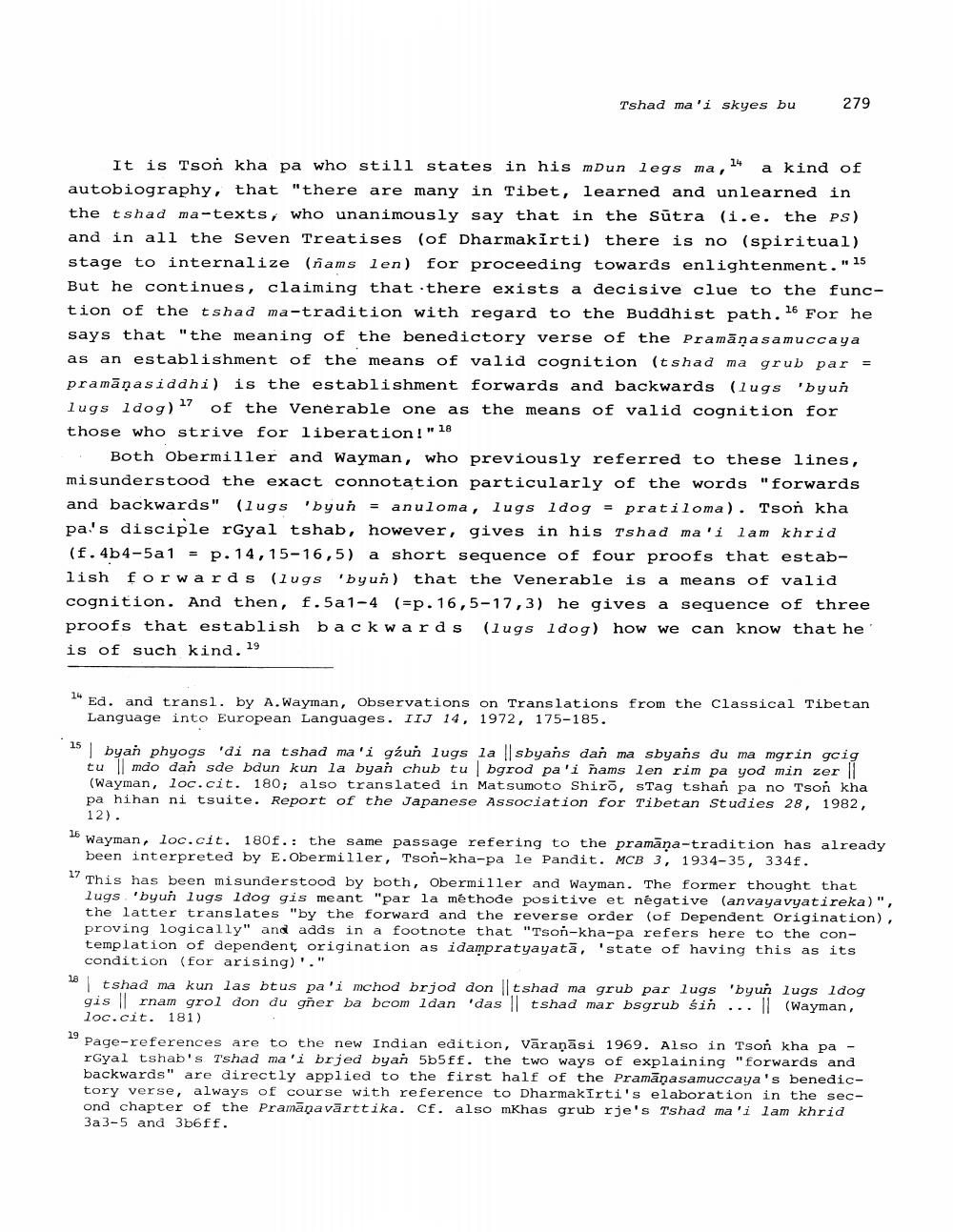Book Title: Meaning And Historical Significance Of Term Author(s): Ernst Steinkellner Publisher: Ernst Steinkellner View full book textPage 5
________________ Tshad ma'i skyes bu 279 It is Tson kha pa who still states in his mDun legs ma, 14 a kind of autobiography, that "there are many in Tibet, learned and unlearned in the tshad ma-texts, who unanimously say that in the Sūtra (i.e. the PS) and in all the Seven Treatises (of Dharmakirti) there is no (spiritual) stage to internalize (nams len) for proceeding towards enlightenment." 15 But he continues, claiming that there exists a decisive clue to the function of the tshad ma-tradition with regard to the Buddhist path. 16 For he says that "the meaning of the benedictory verse of the Pramāṇasamuccaya as an establishment of the means of valid cognition (tshad ma grub par = pramāṇasiddhi) is the establishment forwards and backwards (lugs 'byun lugs ldog) 17 of the Venerable one as the means of valid cognition for those who strive for liberation !" 18 Both Obermiller and Wayman, who previously referred to these lines, misunderstood the exact connotation particularly of the words "forwards and backwards" (lugs 'byun = anuloma, lugs ldog = pratiloma). Tson kha pa's disciple rGyal tshab, however, gives in his Tshad ma'i lam khrid (f. 4b4-5a1 = p.14, 15-16,5) a short sequence of four proofs that establish forwards (lugs 'byun) that the Venerable is a means of valid cognition. And then, f.5a1-4 (=p. 16,5-17,3) he gives a sequence of three proofs that establish backwards (lugs ldog) how we can know that he is of such kind. 19 14 Ed. and transl. by A. Wayman, Observations on Translations from the classical Tibetan Language into European Languages. IIJ 14, 1972, 175-185. 15 byan phyogs 'di na tshad ma'i gzun lugs la l| sbyans dan ma sbyans du ma mgrin gcig tu || mdo dan sde bdun kun la byan chub tubgrod pa'i nams len rim pa yod min zer | (Wayman, loc.cit. 180; also translated in Matsumoto Shiro, stag tshan pa no Tson kha pa hihan ni tsuite. Report of the Japanese Association for Tibetan Studies 28, 1982, 12). Wayman, loc.cit. 180f.: the same passage refering to the pramāņa-tradition has already been interpreted by E.Obermiller, Tson-kha-pa le Pandit. MCB 3, 1934-35, 334f. 17 This has been misunderstood by both, Obermiller and Wayman. The former thought that lugs 'byun lugs ldog gis meant "par la méthode positive et negative (anvaya vyatireka)", the latter translates "by the forward and the reverse order (of Dependent Origination), proving logically" and adds in a footnote that "Tson-kha-pa refers here to the contemplation of dependent origination as idampratyayatā, 'state of having this as its condition (for arising)'." 1 tshad ma kun las btus pa'i mchod brjod don || t shad ma grub par lugs 'byun lugs Idog gis | rnam grol don du gñer ba bcom ldan 'das Il tshad mar bsgrub śin ... Il (Wayman, loc.cit. 181) 19 Page-references are to the new Indian edition, Vāraṇāsi 1969. Also in Tson kha pa - rGyal tshab's Tshad ma'i brjed byan 5b5ff. the two ways of explaining "forwards and backwards" are directly applied to the first half of the Pramānasamuccaya's benedictory verse, always of course with reference to Dharmakirti's elaboration in the second chapter of the Pramāņavārttika. Cf. also mKhas grub rje's Tshad ma'i lam khrid 3a 3-5 and 3b6ff.Page Navigation
1 ... 3 4 5 6 7 8 9 10 11
